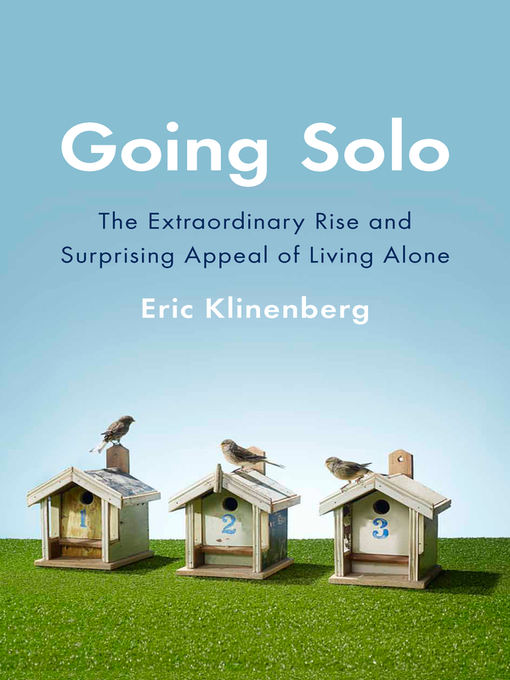Klinenberg shows that most single dwellers—whether in their twenties or eighties—are deeply engaged in social and civic life. There's even evidence that people who live alone enjoy better mental health and have more environmentally sustainable lifestyles. Drawing on more than three hundred in-depth interviews, Klinenberg presents a revelatory examination of the most significant demographic shift since the baby boom and offers surprising insights on the benefits of this epochal change.
-
Creators
-
Publisher
-
Release date
February 2, 2012 -
Formats
-
Kindle Book
-
OverDrive Read
- ISBN: 9781101559802
-
EPUB ebook
- ISBN: 9781101559802
- File size: 374 KB
-
-
Languages
- English
-
Reviews
-
Publisher's Weekly
October 3, 2011
Tackling the growing phenomenon of living alone, sociologist Klinenberg (Heat Wave) examines the roots of the trend in the modern cult of the individual, the feminist liberation from the “burden of the ‘women’s role’ in marriage,” and the Greenwich Village bohemians of the early 20th century. Now, with divorce rates soaring and employment stability at a low, Westerners have gotten used to moving fluidly among cities, jobs, and partners, putting off marriage. At the same time, young people have reframed solo dwelling as a first step into adult independence, shaking some of its old stigma. Klinenberg portrays a number of young urban professionals who enjoy the good life and stay hyperconnected through social media; middle-aged divorcés with little faith in marriage and a fierce desire to protect their independence; widows and widowers forging new networks in assisted living facilities. On the flip side of the coin are the isolated and the poor, homebound by disabilities, forced into single-room occupancy dwellings by poverty, addiction, or disease. With such wide-ranging lifestyles, singletons often find it hard to band together to promote their social and political causes. Still, they share a number of common difficulties, and Klinenberg takes an optimist’s look at how society could make sure singles—young and old, rich and poor—can make the connections that support them in their living spaces and beyond. -
Kirkus
November 1, 2011
Klinenberg (Sociology/New York Univ.; Fighting for Air: The Battle to Control America's Media, 2007, etc.) explores why "more than 50 percent of American adults are single"--and why the usually prefer to live that way. Solo living appears to be a global phenomenon that has skyrocketed over the past decade. The author examines both ends of the age spectrum in an attempt to understand the social implication of this trend. He finds that among relatively affluent young adults in the 25-to-34 age bracket, living solo is seen as a rite of passage into adulthood--a period allowing more sexual freedom, a chance to explore relationships without commitment and a major focus on career building. A similar increase in solitary living is becoming the norm among the elderly, where one in three people over 65 live alone--compared to one in 10 in 1950. This book is an outgrowth of a study conducted by Klinenberg following the publication of his book Heat Wave (2003), which investigated the tragic deaths of senior citizens during the extraordinary heat wave in Chicago in 1995. Interviewing elderly Manhattan residents who live alone, the author found that they preferred this to dependence on their children because of their strong belief in self-reliance. They reject the alternative of assisted living as prohibitively expensive and deplore the conditions in most nursing homes. Klinenberg suggests that public support is needed to provide affordable, urban assisted-living facilities in which the elderly can maintain their independence for as long as possible. An optimistic look at shifting social priorities that need not threaten our fundamental values.(COPYRIGHT (2011) KIRKUS REVIEWS/NIELSEN BUSINESS MEDIA, INC. ALL RIGHTS RESERVED.)
-
Library Journal
Starred review from December 1, 2011
John Donne ("No man is an island") and evidence of the "marriage advantage" to the contrary, Klinenberg (sociology, New York Univ.; Heat Wave: A Social Autopsy of Disaster in Chicago) paints a compelling picture of the new trend toward "singletons." Not much has been written about the fact that more than 50 percent of Americans are now single, with 28 percent of the population (mostly women) actually living alone. Klinenberg identifies four circumstances that have allowed this to happen: recognition of women's rights; vastly improved communication systems; the growth of cities; and longer life spans. Where solitary time and exile were once considered punishments, people on their own today enjoy the personal and intellectual satisfactions that come from being self-reliant--something Emerson and Thoreau recognized centuries ago. VERDICT With articles in the New York Times Magazine, Rolling Stone, and Slate and appearances on the radio program This American Life, Klinenberg is at ease in both scholarly and popular milieus, and his book is recommended for libraries and individuals in both worlds.--Ellen Gilbert, Princeton, NJ
Copyright 2011 Library Journal, LLC Used with permission.
-
Formats
- Kindle Book
- OverDrive Read
- EPUB ebook
subjects
Languages
- English
Loading
Why is availability limited?
×Availability can change throughout the month based on the library's budget. You can still place a hold on the title, and your hold will be automatically filled as soon as the title is available again.
The Kindle Book format for this title is not supported on:
×Read-along ebook
×The OverDrive Read format of this ebook has professional narration that plays while you read in your browser. Learn more here.



